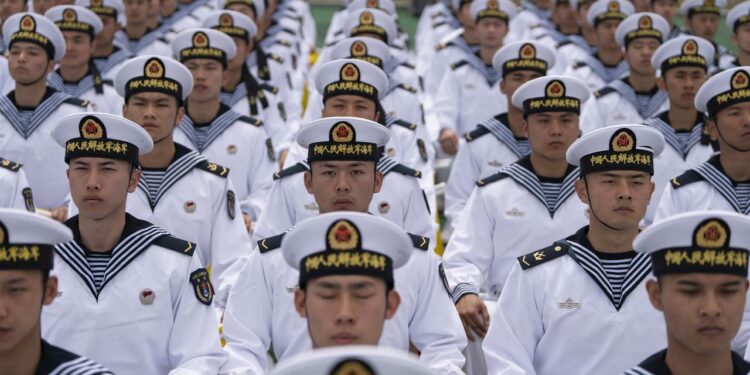– What are some examples of China’s military modernization efforts in recent years?
China’s Military Buildup and Threats to Neighbors: The Growing Power in Asia
China’s military modernization and expansion have been the subject of much speculation and concern in recent years. As the world’s most populous country and second-largest economy, China has been investing heavily in its military capabilities, leading to increased tensions with its neighbors in the Asia-Pacific region. This article will explore the implications of China’s military buildup and the potential threats it poses to its neighbors.
The Rise of China’s Military Power
China’s military has undergone a rapid transformation in recent decades, shifting from a largely land-based force to a more modern and sophisticated military with advanced capabilities in areas such as cyber warfare, space operations, and naval power. The country’s defense budget has grown significantly, allowing for the development of new weapons systems and technologies.
One of the most prominent examples of China’s military buildup is its expansive naval expansion, which has seen the construction of new aircraft carriers, submarines, and surface vessels. China’s naval capabilities have expanded to the point where it now has the largest navy in Asia, with the ability to project power far beyond its shores.
Implications for Neighboring Countries
The growing power of China’s military has raised concerns among its neighboring countries in the Asia-Pacific region. China’s territorial claims in the South China Sea, for example, have led to increased tensions with countries such as Vietnam, the Philippines, and Malaysia, which also claim parts of the disputed waters. China’s aggressive actions in the region, including the militarization of artificial islands and the establishment of air defense zones, have raised fears of potential conflict.
In addition to maritime disputes, China’s military modernization has also raised concerns among countries such as Japan, South Korea, and India, which view China’s growing power as a potential threat to their own security. China’s expanding military presence in the region has led to increased defense spending and the development of new military capabilities among these countries in response.
Regional Responses
In response to China’s military buildup, many of its neighboring countries have sought to strengthen their own defense capabilities and enhance security cooperation with allies such as the United States. Japan, for example, has increased its defense budget and expanded its maritime patrol and missile defense capabilities. South Korea has also bolstered its military forces and increased cooperation with the US military in the region.
Furthermore, countries in the region have sought to enhance security cooperation through mechanisms such as the Quadrilateral Security Dialogue (Quad), which brings together the US, Japan, India, and Australia to address common security challenges in the region. The Quad has conducted joint military exercises and coordinated responses to regional security threats, including China’s military expansion.
Conclusion
China’s military buildup poses significant challenges to its neighboring countries in the Asia-Pacific region, leading to increased tensions and concerns about potential conflict. As China continues to expand its military capabilities, the region is likely to see further efforts by neighboring countries to strengthen their own defenses and enhance security cooperation with allies. It is essential for countries in the region to engage in diplomatic dialogue and confidence-building measures to prevent miscalculations and maintain stability in the region.
Key Facts:
| Country | Response |
|---|---|
| Japan | Increased defense budget and enhanced maritime capabilities |
| South Korea | Bolstered military forces and increased cooperation with US military |
| India | Participation in Quad security dialogue and joint military exercises |
| Australia | Enhanced security cooperation with Quad partners |
Title: China’s Military Expansion in Asia
Background
China currently possesses one of the most powerful armies globally and continues to expand its arsenal to support its ambitions. This expansion is particularly concerning for Taiwan and the Philippines.
China’s Military Strength
The Chinese military has undergone significant modernization and expansion in recent years, making it a formidable force in the region. With a large number of troops, advanced weaponry, and growing technological capabilities, China now poses a significant threat to its neighbors.
Implications for Taiwan
Taiwan finds itself in a precarious position due to China’s military buildup. The possibility of an invasion or coercion from Beijing looms large, prompting Taiwan to enhance its own defense capabilities and seek support from international allies.
Concerns for the Philippines
The Philippines also faces challenges from China’s military activities, particularly in the South China Sea. The ongoing territorial disputes between the two countries have escalated tensions, with Manila feeling the pressure to defend its sovereignty against Chinese incursions.
The Regional Impact
The escalating military presence of China not only affects individual countries like Taiwan and the Philippines but also has broader implications for regional stability. Neighboring nations are closely monitoring these developments and adjusting their defense strategies accordingly.
Influencing Factors
A variety of factors contribute to China’s military expansion, including geopolitical ambitions, historical grievances, and economic interests. Understanding these drivers is crucial for formulating effective responses to counterbalance China’s growing influence in Asia.
A recent report on Chinese state television CCTV showcases Chinese warships at sea. The narrator describes a situation where China’s navy allegedly successfully repels foreign ships attempting to disrupt Chinese military exercises. The State and Party leader, Xi Jinping, is also praised for transforming the Chinese armed forces into a world-class military.
This propaganda aligns with the Communist Party’s agenda in the People’s Republic of China, which governs autocratically and directly controls the military. State television has a dedicated channel focused entirely on the Chinese military, showcasing tanks, combat planes, and aircraft carriers while signaling readiness for combat and warning against foreign interference.
Pressure on the Philippines and Taiwan
Recent developments have put both the Philippines and Taiwan in a challenging position. China’s stance was made clear during a recent press conference at the Ministry of Foreign Affairs in Beijing. The message was straightforward: The United States should refrain from interfering in China’s relations with the Philippines, particularly regarding their activities in the South China Sea. This statement came after the US government announced plans to increase financial aid to the Philippine military.
The naval and coast guard forces of the Philippines are facing escalating pressure from China, which claims a significant portion of territory in the South China Sea as its own. Furthermore, China has expressed concerns over increased military cooperation between Japan and the United States, as well as joint military exercises involving Japan and Taiwan. This is particularly sensitive for China, given its longstanding claim over Taiwan as part of its sovereign territory.
China’s government has already issued a warning to Germany about the Bundeswehr ships currently operating in the Indo-Pacific region, advising against passing through the Taiwan Strait. Despite this caution, the German government is hesitant to rule out this possibility, citing the principles of freedom of navigation in international waters.
Strong Military Presence
China’s Military Strength and Its Threat to Taiwan
China regularly conducts military exercises around the democratically governed island of Taiwan and threatens military action if it does not peacefully reunite with the communist People’s Republic. While international observers believe that China is not yet capable of taking over Taiwan, there are concerns about potential accidental clashes due to China’s increasingly assertive behavior and rising defense spending.
Overview of China’s Military Power
Although much remains unknown about China’s military, some key statistics reveal its strength. With two million soldiers, 510,000 reservists, and the People’s Armed Police, China boasts the largest navy and army in terms of personnel. Professor May-Britt Stumbaum highlights that China operates its defense industry round-the-clock to maintain its growing arsenal.
Expansion of Nuclear Arsenal
In addition to conventional forces, China is expanding its nuclear weapons arsenal. The US Department of Defense estimates that China currently possesses at least 500 nuclear warheads, a number expected to double by the end of this decade.
Implications for Regional Security
As China continues to enhance its military capabilities across land, sea, air, and now in nuclear warfare as well – it poses a significant challenge for regional security in Asia-Pacific. The growing presence of Chinese forces near Taiwan raises concerns among neighboring countries about Beijing’s intentions and how they may affect stability in the region.
Looking Ahead
Given these developments, understanding and monitoring China’s military expansion remain crucial for policymakers worldwide. As tensions persist around issues like Taiwan sovereignty or territorial disputes in the South China Sea – maintaining a delicate balance between deterrence measures while avoiding escalation will be essential moving forward.Title: The Growing Influence of Chinese Technology Companies
In recent years, Chinese technology companies have become increasingly influential on the global stage. This has been fueled by the rapid growth and innovation of companies like Alibaba, Tencent, and Huawei. These companies have not only expanded their reach within China but have also made significant inroads into international markets.
Expanding Global Reach
One of the key factors driving the influence of Chinese technology companies is their expanding global reach. Alibaba, for example, has become one of the world’s largest e-commerce platforms, rivaling Amazon in terms of revenue and market share. Similarly, Tencent’s WeChat has grown to become one of the most popular messaging apps globally, with over a billion active users.
Additionally, Huawei has emerged as a major player in the telecommunications industry, with its 5G technology being adopted by countries around the world. This expansion into international markets has given Chinese technology companies a greater presence and influence on a global scale.
Impact on Innovation
Chinese technology companies have also had a significant impact on innovation in the tech industry. Companies like Alibaba and Tencent have been at the forefront of developing new technologies such as artificial intelligence (AI) and virtual reality (VR). These innovations have not only driven growth within China but have also shaped trends and standards worldwide.
Furthermore, Chinese companies are investing heavily in research and development (R&D), fueling further innovation in areas such as cloud computing, fintech, and smart cities. This focus on innovation has positioned Chinese technology firms as leaders in emerging technologies that will shape the future economy.
Challenges Ahead
Despite their successes, Chinese technology companies face challenges as they continue to expand globally. One major challenge is regulatory scrutiny from foreign governments concerned about data security and privacy issues. Companies like Huawei have faced backlash from countries like the United States over concerns about espionage risks related to 5G networks.
Moreover, competition from other tech giants like Google and Apple presents another challenge for Chinese firms looking to maintain their market dominance internationally. These challenges highlight the need for continued investment in R&D and strategic partnerships to navigate complex regulatory environments.
In conclusion…
The growing influence of Chinese technology companies represents a shift in power dynamics within the industry towards Asia-Pacific regions..companies ..(centres)..to watch…as they navigate global markets while driving innovation..are..positioned..to lead..future technological advancements…Seo Keywords: chinese technology companies,chinese tech giants,chinese innovations














